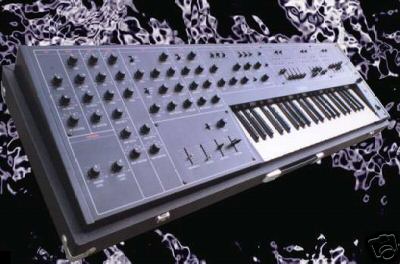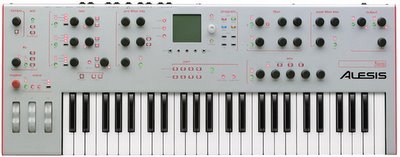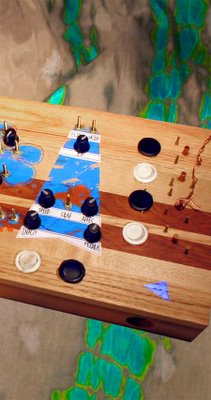
Thursday, March 02, 2006
Nice Space Heater
 Another via Mattias. It's a wall of oscilloscopes. Title link takes you to a bigger shot. Also make sure to check out Mattias' site.
Another via Mattias. It's a wall of oscilloscopes. Title link takes you to a bigger shot. Also make sure to check out Mattias' site.
SynthModules.com and the PSIM-1
 Title link takes you to the SynthModules site. The PSIM-1 is currently sold out. Details on the PSIM-1: "The heart of this module is a powerful miniature computer (microcontroller) that processes 100,000 instructions per second. It is programmed with your Windows based PC in a simple and easy to learn form of BASIC. Each of the four analog outputs can be programmed to output 1V/Octave CV-OUT as a pattern sequencer and complex event generator, or simply as a gate. This is just the beginning. Use any of its four analog outputs as a programmable LFO to gate your ADSR and set up extremely complex filter sweeps. Clock your Binary Zone with complex events. Imagine what you can do with your filters! Generate CV along with extremely complex sequences that are only limited by your imagination. Unlike most typical analog sequencers, you can change the timing of the spaces between notes and/or gates. Like I said, this is all just the beginning. Additional add-on modules will follow. Unlike a one-time programmable ROM, you can change the program anytime you wish by simply plugging in a cable and downloading the changes to your module. The program remains in memory even with the power off until the next time you want to change the program. Once programmed, you can disconnect your computer and use it as you would any other module. Want random gate and CV sequences? Here you go! Change a few lines of code and you have chaos at it's finest! "
Title link takes you to the SynthModules site. The PSIM-1 is currently sold out. Details on the PSIM-1: "The heart of this module is a powerful miniature computer (microcontroller) that processes 100,000 instructions per second. It is programmed with your Windows based PC in a simple and easy to learn form of BASIC. Each of the four analog outputs can be programmed to output 1V/Octave CV-OUT as a pattern sequencer and complex event generator, or simply as a gate. This is just the beginning. Use any of its four analog outputs as a programmable LFO to gate your ADSR and set up extremely complex filter sweeps. Clock your Binary Zone with complex events. Imagine what you can do with your filters! Generate CV along with extremely complex sequences that are only limited by your imagination. Unlike most typical analog sequencers, you can change the timing of the spaces between notes and/or gates. Like I said, this is all just the beginning. Additional add-on modules will follow. Unlike a one-time programmable ROM, you can change the program anytime you wish by simply plugging in a cable and downloading the changes to your module. The program remains in memory even with the power off until the next time you want to change the program. Once programmed, you can disconnect your computer and use it as you would any other module. Want random gate and CV sequences? Here you go! Change a few lines of code and you have chaos at it's finest! "Update via the comments: "Too bad the guy that sells these doesn't actually deliver them - dozens and dozens of people paid him in full for them over 2 years ago and he still hasn't delivered. Many are considering legal action. It's a great module, but I wouldn't recommend doing business with the guy. There's currently talk on the synthmodules yahoo group about creating a better DIY version of this... "
Alesis ION Filter Types
There has been some discussion on AH on the Alesis ION filter types. It's interesting that they are not listed in detail on the Alesis site. I thought I'd put up a post with the list so far. Title link takes you to a Sound on Sound review of the ION where the majority of the below came from. However, some new filters also listed below, were added since the SOS reveiw. Here's a link to the details on the OS updates to date.

'mg': a four-pole low-pass modelled on that of the most famous monophonic analogue synth ever made.
'ob': a two-pole low-pass closely resembling the one in a classic synth xpander... whoops, I mean expander module.
'ob': a two-pole band-pass.
'ob': a two-pole high-pass.
'rp': a four-pole low-pass modelled on the one in a popular semi-modular synth.
'tb': a three-pole low-pass (think 'little silver bass synth').
'jp': a four-pole low-pass (from an eight-voice synth noted for its coloured buttons amongst other things);
'Eight-pole low-pass': all the filters from here on were created for the Ion; this one gives a very steep cutoff.
'8ve dual band-pass': two two-pole band-pass filters spaced one octave apart.
'six-pole band-pass': like an exaggerated version of the 'ob' band-pass.
'phase warp': an analogue phaser effect based on eight all-pass filters in series.
'comb filter 1': multiple resonant peaks and notches which are not harmonically related.
'comb filter 2': as above, but the signal is additionally filtered to warm up the sound.
'vocal formant 1': three band-pass filters emulating 'ah' and 'oo' vowel sounds.
'vocal formant 2': as above, but 'oh' and 'ee' vowel sounds.
'vocal formant 3': a five-band formant filter.
'band limit': a two-pole high-pass filter and a two-pole low-pass filter in series, limiting the signal to everything between them; resonance adjusts bandwidth.
New Types:
'OP 4-Pole Highpass - This filter is based on our "MG" 4-pole lowpass filter model. It has a steeper cut-off and more extreme resonance than the "OB" highpass. Like the "MG", it will self-oscillate when the resonance is turned all the way up. It can thus be used as a fourth (or fifth) oscillator.
'Comb 3 - Based on a different design than Comb's 1 and 2, it has deeper notches and more pronounced resonance.
'Comb 4 - Similar to Comb3, but with negative feedback. This will oscillate and even clip when the resonance is turned up.

'mg': a four-pole low-pass modelled on that of the most famous monophonic analogue synth ever made.
'ob': a two-pole low-pass closely resembling the one in a classic synth xpander... whoops, I mean expander module.
'ob': a two-pole band-pass.
'ob': a two-pole high-pass.
'rp': a four-pole low-pass modelled on the one in a popular semi-modular synth.
'tb': a three-pole low-pass (think 'little silver bass synth').
'jp': a four-pole low-pass (from an eight-voice synth noted for its coloured buttons amongst other things);
'Eight-pole low-pass': all the filters from here on were created for the Ion; this one gives a very steep cutoff.
'8ve dual band-pass': two two-pole band-pass filters spaced one octave apart.
'six-pole band-pass': like an exaggerated version of the 'ob' band-pass.
'phase warp': an analogue phaser effect based on eight all-pass filters in series.
'comb filter 1': multiple resonant peaks and notches which are not harmonically related.
'comb filter 2': as above, but the signal is additionally filtered to warm up the sound.
'vocal formant 1': three band-pass filters emulating 'ah' and 'oo' vowel sounds.
'vocal formant 2': as above, but 'oh' and 'ee' vowel sounds.
'vocal formant 3': a five-band formant filter.
'band limit': a two-pole high-pass filter and a two-pole low-pass filter in series, limiting the signal to everything between them; resonance adjusts bandwidth.
New Types:
'OP 4-Pole Highpass - This filter is based on our "MG" 4-pole lowpass filter model. It has a steeper cut-off and more extreme resonance than the "OB" highpass. Like the "MG", it will self-oscillate when the resonance is turned all the way up. It can thus be used as a fourth (or fifth) oscillator.
'Comb 3 - Based on a different design than Comb's 1 and 2, it has deeper notches and more pronounced resonance.
'Comb 4 - Similar to Comb3, but with negative feedback. This will oscillate and even clip when the resonance is turned up.
Wednesday, March 01, 2006
Jim Aikin on Melody Over Texture
Update: Make sure to check out the comments section of this post for some good dialog going on.
Jim Aikin, former senior editor of Keyboard magazine, posted the following on the SynthSights list. It's an interesting perspective on why many people will identify more with melody over texture of sound - why musical hooks will usually get stuck in our heads more likely than synth soundscapes. I asked Jim if I could post this and he gave me the ok. Thanks Jim! Title link takes you to Jim Aikin's website.
"My suspicion is that our ability to sense and respond to pitch inflection
(i.e., melody) has evolutionary roots in our ability to understand language.
Even in languages that use pitch inflection to distinguish one word from
another, I'm sure speakers and listeners understand the difference in affect
between a sentence spoken in a high, rapid tone with exaggerated pitch
changes and the same sentence spoken in a low, hesitant monotone.
Musical perception uses the same brain mechanisms.
Textures can be instantly identifiable, even before the entrance of motivic
content, and can carry a profound emotional charge. But I doubt that a
texture stays in your head and comes back to you at odd moments the way a
melody by Mozart or Lennon & McCartney will.
Again, it's evolution at work. A melody uses syntax, so it gets "filed" by
the brain using the same ultra-sophisticated language-handling modules that
allow you to remember, word for word, what your Significant Other (or, for
that matter, a total stranger) said to you last week. Most listeners don't
have the mental equipment to handle texture and tone color in that way.
The weakness that I've observed in far too many synth-based CDs (and I used
to listen to a lot of them when I was at Keyboard) is that while the opening
texture is beautiful and stimulating, the music never goes anywhere. The
melodic and harmonic structure, if it exists at all, fails to hold my
attention.
I suppose this is ultimately an elitist position in favor of the
old-fashioned virtues taught in college-level composition courses. But the
music itself doesn't have to be elitist...
Them's mah 2 cents, and ah'm stickin' to 'em."
--Jim Aikin
Jim Aikin, former senior editor of Keyboard magazine, posted the following on the SynthSights list. It's an interesting perspective on why many people will identify more with melody over texture of sound - why musical hooks will usually get stuck in our heads more likely than synth soundscapes. I asked Jim if I could post this and he gave me the ok. Thanks Jim! Title link takes you to Jim Aikin's website.
"My suspicion is that our ability to sense and respond to pitch inflection
(i.e., melody) has evolutionary roots in our ability to understand language.
Even in languages that use pitch inflection to distinguish one word from
another, I'm sure speakers and listeners understand the difference in affect
between a sentence spoken in a high, rapid tone with exaggerated pitch
changes and the same sentence spoken in a low, hesitant monotone.
Musical perception uses the same brain mechanisms.
Textures can be instantly identifiable, even before the entrance of motivic
content, and can carry a profound emotional charge. But I doubt that a
texture stays in your head and comes back to you at odd moments the way a
melody by Mozart or Lennon & McCartney will.
Again, it's evolution at work. A melody uses syntax, so it gets "filed" by
the brain using the same ultra-sophisticated language-handling modules that
allow you to remember, word for word, what your Significant Other (or, for
that matter, a total stranger) said to you last week. Most listeners don't
have the mental equipment to handle texture and tone color in that way.
The weakness that I've observed in far too many synth-based CDs (and I used
to listen to a lot of them when I was at Keyboard) is that while the opening
texture is beautiful and stimulating, the music never goes anywhere. The
melodic and harmonic structure, if it exists at all, fails to hold my
attention.
I suppose this is ultimately an elitist position in favor of the
old-fashioned virtues taught in college-level composition courses. But the
music itself doesn't have to be elitist...
Them's mah 2 cents, and ah'm stickin' to 'em."
--Jim Aikin
The Cocolase System

Title link takes you there.
"The Cocolase has two 8 bit digital delays, but it does not just delay sounds, it recontextualizes them in different pitches, directions, all broken up or all melded together. Each delay has sensing inputs to control its speed, direction, and location. In the center of the Cocolase is a woven nest of 8 oscillators called a Sidrassi. The Sidrassi manifests many varieties of movement with which to control the delays."
Lunchbreak
New Modcan Dual Quantizer 55B Module
 Title link takes you there. Link at the very bottom left of the list when you get there. Demos online.
Title link takes you there. Link at the very bottom left of the list when you get there. Demos online. Dual Quantizer module. Two discrete circuits, functionally
independent and identical.
Converts continuous signal to DC step output voltage conforming to typical musical scales.
Mode 1: Functionally equivalent to a Sample and Hold.
Voltage step will only change with a rising edge pulse or trigger applied to the CLOCK input jack.
Unique design requires no hold capacitor.
Result is zero 'droop' and infinite hold.
Ideal use of mode 1 is in conjunction with a sequencer.
The sequencer gate bus can be used to initiate the sampling
of each sequencer step.
Mode 2: No-Clock or free mode.
Voltage step output changes automatically when the input crosses the conversion threshold determined by the scale selected.
This is the mode users will be familiar with when using the MiniWave to quantize. The one difference here is that with each transition a 5ms pulse is output from the PULSE out jack. This provides the ability to trigger envelopes or logic inputs in synch with step changes.
International Musician Rhodes Chroma Review
Title link takes you to the January 1983 review reprinted on the Rhodes Chroma site.
"The Chroma is a very interesting chap, as it doesn't quite fit into the Prophet, OBXA, JP8 league, nor does it fit into the Fairlight, Synclavier, PPGs ot. It seems to be somewhere between both categories, which may or may not be a good thing, only time/sales will tell? Despite the fact that it offers far more versatility than most synthes it is a pain to edit. You have to use the manual to remember all the information, unless you've got a photostatic memory, which I definitely haven't."
Update from Jimmy in the comments: "Fun Trivia - I believe the reviewer was the same Paul Fishman who played synths for Re-Flex (The Politics of Dancing)."
"The Chroma is a very interesting chap, as it doesn't quite fit into the Prophet, OBXA, JP8 league, nor does it fit into the Fairlight, Synclavier, PPGs ot. It seems to be somewhere between both categories, which may or may not be a good thing, only time/sales will tell? Despite the fact that it offers far more versatility than most synthes it is a pain to edit. You have to use the manual to remember all the information, unless you've got a photostatic memory, which I definitely haven't."
Update from Jimmy in the comments: "Fun Trivia - I believe the reviewer was the same Paul Fishman who played synths for Re-Flex (The Politics of Dancing)."
PREVIOUS PAGE
NEXT PAGE
HOME













© Matrixsynth - All posts are presented here for informative, historical and educative purposes as applicable within fair use.
MATRIXSYNTH is supported by affiliate links that use cookies to track clickthroughs and sales. See the privacy policy for details.
MATRIXSYNTH - EVERYTHING SYNTH













© Matrixsynth - All posts are presented here for informative, historical and educative purposes as applicable within fair use.
MATRIXSYNTH is supported by affiliate links that use cookies to track clickthroughs and sales. See the privacy policy for details.
MATRIXSYNTH - EVERYTHING SYNTH

























